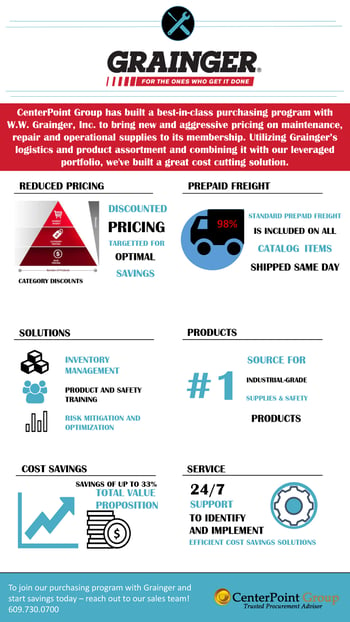MRO spend is what organizations spend to procure the products and services they need for their maintenance, repair, and operations activities. It includes costs for industrial supplies, spare parts, tools, equipment, contracted services, office supplies, and more.
 For most organizations, MRO purchasing accounts for a major portion of their overall procurement budget. Optimizing this spend is crucial to reduce costs and improve operational efficiency.
For most organizations, MRO purchasing accounts for a major portion of their overall procurement budget. Optimizing this spend is crucial to reduce costs and improve operational efficiency.
MRO optimization involves identifying cost-saving opportunities, streamlining procurement processes, and establishing effective supplier relationships. By optimizing MRO spend, as well as their safety and personal protective equipment (PPE) spend, companies can:
- Ensure they have the right items in stock at the right time.
- Minimize excess inventory.
- Bring down inventory costs.
- Reduce downtime.
- Decrease time and effort spent on maintenance.
- Bolster the bottom line.
What, specifically, are the best ways to optimize and reduce MRO spend? At CenterPoint Group, we recommend organizations adopt a combination of several proven strategies.
Effective MRO Optimization Strategies You Should Pursue
Here are eight of the top nine MRO optimization approaches we encourage procurement professionals and teams to implement:
 Dive Deep into Your Data
Dive Deep into Your Data
By analyzing historical data, you can identify trends, usage patterns, and areas of potential savings. Data analytics tools can help identify slow-moving or obsolete inventory.
Data analytics can also help MRO purchasing meet future circumstances. By analyzing sales information, market trends, and seasonal patterns, you can develop predictive models that more accurately forecast future demand. As a result, you can optimize inventory levels, reduce carrying costs, and avoid stockouts or overstocks.
Centralize Your MRO Inventory Data
Before you can analyze your inventory data, you must centralize it. A centralized database lets organizations gather and consolidate inventory data from various sources—production lines, warehouses, distribution centers, and others.
Centralized data eliminates duplication and inconsistencies. It also gives authorized personnel across various departments real-time access to data, leading to better coordination and decision-making.
Put Proactive Preventive Maintenance Protocols in Place
 Preventive maintenance practices use data analytics and machine learning to focus on performing regular inspections, handling routine maintenance, and replacing parts before they fail.
Preventive maintenance practices use data analytics and machine learning to focus on performing regular inspections, handling routine maintenance, and replacing parts before they fail.
Technologies like computerized maintenance management systems (CMMS) can reduce the likelihood of equipment breakdowns, unplanned downtime, and costly emergency repairs.
Adopt Inventory and MRO Purchasing Management Technologies
Inventory management technologies give organizations granular visibility and understanding of inventory levels. For instance, radio-frequency identification (RFID) tags attached to inventory items can enable automated tracking and monitoring, getting rid of the need for manual inventory counts.
Technology can also help optimize MRO purchasing, safety supply spend, and PPE spend. It can automate procurement activities like supplier selection, order placement, and invoice processing. It can reduce paperwork and human error, while ensuring compliance with procurement policies and contracts.
Foster Stronger Maintenance–Procurement Communication
Robust communication between your organization's maintenance and procurement teams is essential for optimized MRO spend.
The maintenance team provides insights into their usage patterns and equipment requirements. The procurement team applies this information to the MRO supply chain by sourcing the right materials and negotiating better prices.
Strengthen Your Supplier Relationships
You must also establish and maintain clear channels of communication with suppliers. Such communication ensures both parties are aligned on requirements and goals. It builds trust and helps suppliers adjust operations and capabilities. It can lead to their improved performance and reduced costs for you.
In addition, you must evaluate and monitor suppliers' performance to be sure they meet expectations. Your organization should establish key performance indicators (KPIs) to measure supplier performance and proactively address any deviations.
Consolidate Your MRO Supplier Pool
Many organizations have a wide range of suppliers in their MRO supply chain. This situation often leads to inefficiencies and higher costs.
MRO consolidation entails establishing strategic partnerships with a selected few suppliers. Such consolidation helps you streamline procurement processes, negotiate better pricing terms, and unlock volume discounts. Plus, you'll reduce the time and effort you spend sourcing and managing multiple vendors.
Negotiate Favorable Long-Term Contracts
Organizations can often secure better pricing, volume discounts, and other benefits by committing to long-term partnerships. Long-term contracts provide stability, reduce the risk of MRO supply chain disruptions, and enable both organizations to plan operations and investments more effectively.
As market dynamics change, you must review and renegotiate long-term contracts. By aligning contracts with current requirements, you can leverage new opportunities and maintain competitive pricing.
Group Purchasing Organizations Help Drive MRO Optimization
Not all organizations possess sufficient "clout" to negotiate the most favorable pricing and other terms in their MRO supply chain. Working with a group purchasing organization (GPO) can help.
CenterPoint is an industry-leading GPO and procurement adviser that can help your business optimize its MRO spend, safety supply spend, and PPE spend.
Our extensive network of suppliers with whom we have long-standing relationships affords our members unparalleled access to products and services at the best possible prices. For example, we work with Grainger, one of the United States’ most trusted names in industrial-grade MRO supplies, to ensure our members can procure more than 1.5 million products.
And our members’ savings with Grainger can add up fast. Saving up to 33% on supplies through a CenterPoint contract with Grainger lets companies relieve tremendous pressure on their bottom line.
When you work with CenterPoint, then, you're leveraging our members' collective purchasing power to ensure you're getting products and services at the best possible price. You're also harnessing our ability to give you pinpoint-accurate information on which to base your MRO decisions.
See how CenterPoint can help your organization optimize its MRO purchasing. Request your free pricing analysis today.



Leave a Reply
Comment policy: We love comments and appreciate the time that readers spend to share ideas and give feedback. However, all comments are manually moderated and those deemed to be spam or solely promotional will be deleted.